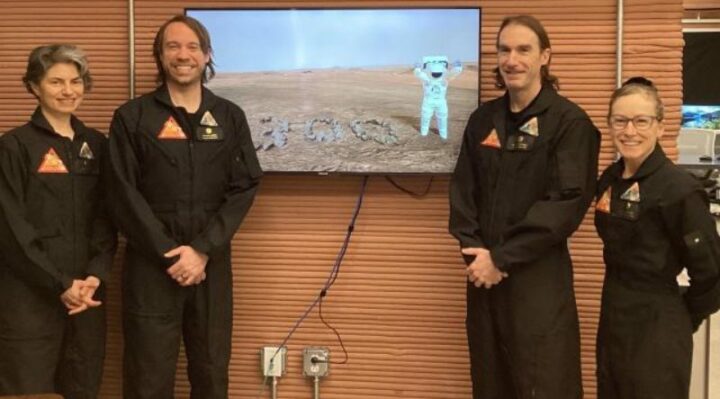
After a yearlong journey that never left Earth, the crew of a NASA mission to Mars stepped out of their craft.
The four volunteer crew members left NASA’s first artificial Mars habitat at Houston’s Johnson Space Center on Saturday at around five o’clock in the evening, having spent more than a year there.
On June 25, 2023, Kelly Haston, Anca Selariu, Ross Brockwell, and Nathan Jones—the first crew members of the space agency’s Crew Health and Performance Exploration Analog project—entered the 3D-printed housing.
The mission commander, Haston, greeted everyone with a polite “Hello.”
“It’s actually just so wonderful to be able to say ‘hello’ to you all,” she remarked.
The mission medical officer, Jones, a doctor, stated their 378 days in captivity “went by quickly.”
The group of four individuals occupied a 1,700 square foot (157 square meter) area, simulating a mission to Mars, which is the fourth planet from the sun and a topic of discussion for both science fiction enthusiasts and scientists regarding a potential human journey beyond the moon.
The first CHAPEA crew concentrated on maintaining the habitat and its equipment, cultivating and harvesting vegetables to augment their food, and creating potential conditions for future Mars operations using simulated spacewalks, or “Marswalks.”
According to NASA, they also overcome difficulties that a genuine Mars crew would have, such as scarce resources, isolation, and communication lags of up to 22 minutes with their home planet over the enclosure’s walls.
NASA announced that two more CHAPEA missions are in the works, during which crews will carry out simulated spacewalks and collect data on many aspects of physical and behavioral well-being and performance.
The majority of the first crew’s experiments, according to Johnson Space Center assistant director Steve Koerner, concerned diet and how it influenced their performance. “crucial science as we prepare to send people on to the red planet,” he described the endeavor as.
According to Koerner, “They’ve been separated from their families, placed on a carefully prescribed meal plan and undergone a lot of observation,”
“Mars is our goal,” he declared, describing the project as a critical step toward advancing American leadership in the international space exploration endeavor.
Following a knock on the door by astronaut and deputy director of flight operations Kjell Lindgren, the four volunteers emerged and expressed their gratitude to each other and the people who had patiently waited outside. They also shared the lessons they had learned about life on Earth and a potential manned mission to Mars.
The flight engineer for the crew, Brockwell, stated that the trip taught him the value of leading a sustainable life for the good of all people on Earth.
“I’m grateful for the chance to live the idea that we must use resources no faster than they can be replenished and produce waste no faster than it can be processed back into resources,” Brockwell said. “I’m very grateful to have had this incredible opportunity to live for a year within the spirit of planetary adventure towards an exciting future.”
“We cannot live, dream, create or explore on any significant timeframe if we don’t live these principles, but if we do, we can achieve and sustain amazing and inspiring things like exploring other worlds,” the speaker stated.
Anca Selariu, a science officer, said she was frequently asked why people were so obsessed with Mars.
“Why go to Mars? Because it’s possible,” she remarked. “Because space can unite and bring out the best in us. Because it’s one defining step that ‘Earthlings’ will take to light the way into the next centuries.”



